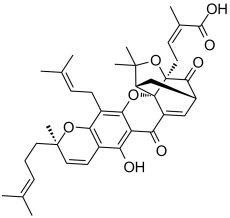Gambogic Acid (Guttatic Acid, Guttic Acid)
This product is for research use only, not for human use. We do not sell to patients.

For small sizes, please check our retail website as below: www.invivochem.com
| Size | Price | Stock |
|---|---|---|
| 250mg | $750 | In Stock |
| 500mg | $1250 | In Stock |
| 1g | $1875 | In Stock |
Cat #: V0033 CAS #: 2752-65-0 Purity ≥ 98%
Description: Gambogic Acid (also called Guttatic Acid, Guttic Acid) is a naturally occurring xanthonoid isolated from the brownish or orange resin from Garcinia hanburyi.
Top Publications Citing Invivochem Products
Publications Citing InvivoChem Products
Product Promise

- Physicochemical and Storage Information
- Protocol
- Related Biological Data
- Stock Solution Preparation
- Quality Control Documentation
| Molecular Weight (MW) | 628.75 |
|---|---|
| Molecular Formula | C38H44O8 |
| CAS No. | 2752-65-0 |
| Storage | -20℃ for 3 years in powder formr |
| -80℃ for 2 years in solvent | |
| Solubility In Vitro | DMSO: 100 mg/mL (159.04 mM)r |
| Water:<1 mg/mL (slightly soluble or insoluble)r | |
| Ethanol: N/A | |
| SMILES Code | O=C(O)/C(C)=C\C[C@@](C([C@]1([H])C=C23)=O)(OC(C)(C)[C@]4([H])C1)[C@@]24OC5=C(C(O)=C(C=C[C@](CC/C=C(C)/C)(C)O6)C6=C5C/C=C(C)\C)C3=O |
| Synonyms | ß-Guttiferrin; ß-Guttiferrin; ß-Guttilactone; Cambogic acid; Guttatic acid; Guttic acid. |
| Protocol | In Vitro | Gambogic Acid (Beta-Guttiferrin) is a medicinal compound derived from the gamboges resin of the tree, Garcinia hanburyi. Gambogic Acid has documented cytotoxic activity against tumor cell lines in culture, with concentrations required for killing 50% of cells (LD50 of ~1 μM). The activity of Gambogic Acid against the 6 human anti-apoptotic Bcl-2-family proteins is contrasted, using FPAs. Gambogic Acid displaces to various extents FITC-BH3 peptide binding to all 6 proteins, with apparent IC50 1.47 μM for Bcl-XL, 1.21 μM for Bcl-2, 2.02 μM for Bcl-W, 0.66 μM for Bcl-B, 1.06 μM for Bfl-1, and 0.79 μM for Mcl-1. |
|---|---|---|
| In Vivo | To further investigate whether Gambogic Acid (Beta-Guttiferrin) synergises CDDP against tumour growth in vivo, A549 tumors are implanted in SCID mice. When mice are treated with CDDP combined with Gambogic Acid, the tumor inhibition rate is 69.3%, whereas those of mice treated with CDDP and GA alone are 57.2% and 29.0%, respectively. |
These protocols are for reference only. InvivoChem does not
independently validate these methods.
| Solvent volume to be added | Mass (the weight of a compound) | |||
|---|---|---|---|---|
| Mother liquor concentration | 1mg | 5mg | 10mg | 20mg |
| 1mM | 1.5905 mL | 7.9523 mL | 15.9046 mL | 31.8091 mL |
| 5mM | 0.3181 mL | 1.5905 mL | 3.1809 mL | 6.3618 mL |
| 10mM | 0.1590 mL | 0.7952 mL | 1.5905 mL | 3.1809 mL |
| 20mM | 0.0795 mL | 0.3976 mL | 0.7952 mL | 1.5905 mL |
The molarity calculator equation
Mass(g) = Concentration(mol/L) × Volume(L) × Molecular Weight(g/mol)
Mass
=
Concentration
×
Volume
×
Molecular Weight*
The dilution calculator equation
Concentration(start)
×
Volume(start)
=
Concentration(final)
×
Volume(final)
This equation is commonly abbreviated as: C1 V1 = C2 V2
Concentration(start)
C1
×
Volume(start)
V1
=
Concentration(final)
C2
×
Volume(final)
V2
Step One: Enter information below
Dosage mg/kg
Average weight of animals g
Dosing volume per animal µL
Number of animals
Step Two: Enter the in vivo formulation
%DMSO
+
%
+
%Tween 80
+
%ddH2O
Calculation Results:
Working concentration:
mg/ml;
Method for preparing DMSO master liquid:
mg
drug pre-dissolved in
µL
DMSO(Master liquid concentration
mg/mL)
,Please contact us first if the concentration exceeds the DMSO solubility of the batch of drug.
Method for preparing in vivo formulation:
Take
µL
DMSO master liquid, next add
µL
PEG300, mix and clarify, next add
µL
Tween 80,mix and clarify, next add
µL
ddH2O,mix and clarify.
Note:
- (1) Please be sure that the solution is clear before the addition of next solvent. Dissolution methods like vortex, ultrasound or warming and heat may be used to aid dissolving.
- (2) Be sure to add the solvent(s) in order.




































